Transform your furniture flipping into a therapeutic practice with these proven stress-relieving methods. Start with mindful wood sanding, focusing on the rhythmic motions while progressing through different grits. Let paint therapy guide your color choices as you apply calming chalk paint in smooth, methodical strokes. Practice gentle distressing techniques and meditative hardware restoration to create authentic vintage charm. Incorporate soothing pattern designs and repetitive stenciling for artistic expression. Try peaceful upholstery work and relaxing wax finishing to round out your practice. These intentional approaches won't just create beautiful pieces – they'll help you discover furniture flipping's deeper restorative benefits.
Mindful Wood Sanding
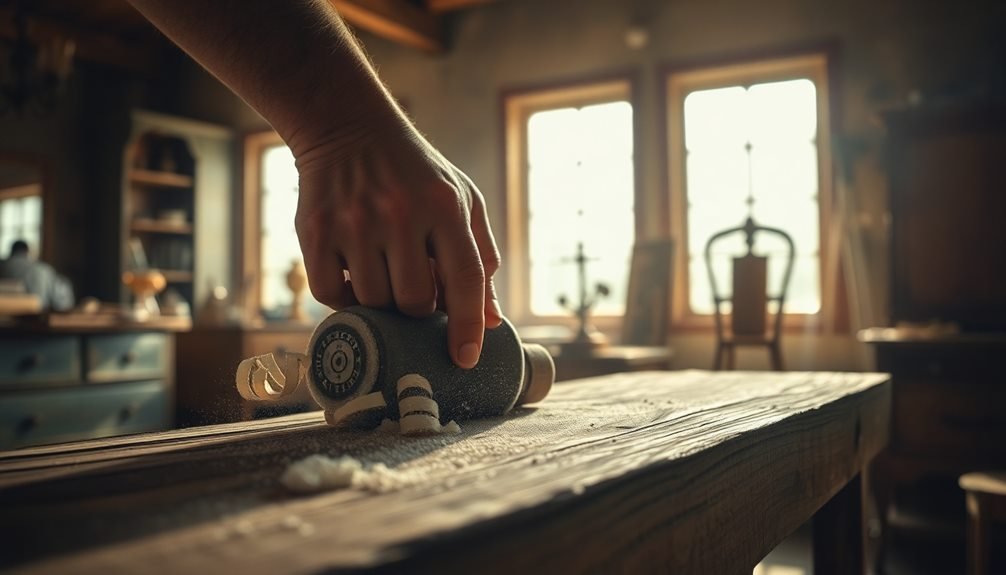
Before diving into furniture restoration, mindful wood sanding offers a therapeutic way to begin your flipping journey. Focus on the repetitive motion as you move the sandpaper across the wood's surface, paying attention to each stroke and the gradual transformation beneath your fingers. You'll feel the rough spots become smooth while releasing daily tensions through this tactile process.
Start with coarse-grit sandpaper (60-80 grit) and maintain steady, even pressure as you work in the direction of the wood grain. Notice how the old finish gradually disappears, revealing the natural beauty underneath.
As you progress to medium-grit (120-150) and fine-grit (220+) papers, concentrate on the changing texture and the satisfying results of your efforts.
Take deep breaths while you work, synchronizing your breathing with your sanding motions. Listen to the subtle scratching sounds and observe the wood dust collecting.
This mindful approach not only guarantees a superior finish but also creates a meditative experience. You'll find that focusing on these sensory details helps clear your mind while accomplishing the essential first step in furniture transformation.
Paint Therapy Color Selection
With your furniture's surface now smooth and ready, selecting paint colors becomes a deeply personal and therapeutic experience.
You'll find that different hues can directly influence your mood and create specific emotional responses during your furniture flipping journey. Consider this color selection process as a form of meditation, where you're connecting with both the piece and your inner creative voice.
When choosing your paint colors, pay attention to how different shades make you feel.
You'll want to select colors that:
- Calm your mind – soft blues and gentle greens can lower anxiety and create a sense of tranquility as you work
- Energize your spirit – vibrant yellows and warm oranges can boost motivation and creative energy
- Ground your emotions – earthy browns and warm grays can help you feel centered and focused
- Uplift your mood – subtle lavenders and peaceful sage tones can promote emotional balance
Don't rush this selection process.
Take time to test various color samples on small sections of your piece, observing how they shift under different lighting conditions.
Trust your intuition – the right color combination will resonate with both your vision and emotional state, making the painting process genuinely therapeutic.
Gentle Distressing Techniques
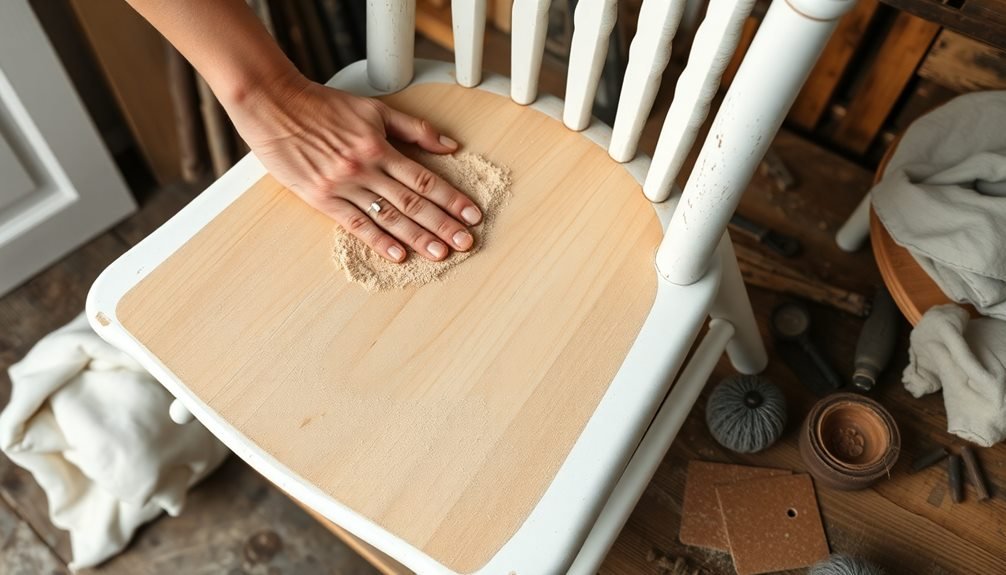
When you're ready to give your piece a vintage look, start by gently sanding along the natural wear points where furniture typically shows age – edges, corners, and high-contact areas.
You'll want to use medium-grit sandpaper and work in the direction of the wood grain, applying light pressure to gradually reveal layers beneath the paint.
These targeted distressing techniques create authentic-looking wear patterns that tell a story and help release stress as you transform your furniture piece.
Sanding for Vintage Appeal
Through gentle sanding techniques, you'll create an authentic aged appearance that transforms modern furniture into cherished vintage pieces. Start with 120-grit sandpaper to remove any existing finish, then progress to 220-grit for smoothing. Focus on areas that naturally wear over time: edges, corners, and high-touch surfaces.
When you're ready to create that coveted vintage look, consider these emotionally satisfying approaches:
- Embrace imperfection by sanding through paint layers to reveal hints of wood or previous colors beneath, creating a story of time passed.
- Let your hands guide you as you work the edges until they feel silky smooth, connecting you to artisans of the past.
- Create natural-looking wear patterns by imagining how generations of hands would have touched and used the piece.
- Feel the therapeutic rhythm of circular motions as you blend newly sanded areas with existing surfaces.
Keep your movements light and controlled, paying attention to how the wood responds to your touch. You'll know you've achieved the right level of distressing when the piece looks naturally aged rather than artificially weathered.
Remember to wipe away all dust with a tack cloth before applying your chosen finish.
Natural Wear Patterns
Creating authentic wear patterns transforms furniture from obviously distressed to naturally aged. You'll want to focus on areas that would naturally experience wear over time, like edges, corners, and high-touch surfaces. By studying vintage pieces, you can identify where genuine aging typically occurs and replicate these patterns convincingly.
| Wear Location | Technique | Tool |
|---|---|---|
| Corners | Light rubbing | Fine steel wool |
| Edges | Gentle scuffing | 220-grit sandpaper |
| Handle areas | Circular motion | Cotton cloth |
When creating natural wear, you'll need to take into account the furniture's intended era and use. A farmhouse table should show different patterns than a formal sideboard. Start with subtle wear on the corners where people might bump into the piece, then gradually work on edges where hands would naturally rest. Don't overdo it – authenticity comes from restraint.
To achieve the most realistic results, layer your distressing techniques. Begin with light sanding, follow with strategic rubbing, and finish by smoothing any harsh marks. Remember that real wear happens gradually, so your distressing should appear random yet logical, following the furniture's natural movement patterns.
Meditative Hardware Restoration
You'll discover tranquility in restoring old hardware through patient wire brushing, letting the gentle back-and-forth motion become a soothing rhythm.
The methodical process of working in small circles with varying brush pressures allows you to focus solely on revealing the metal's natural beauty beneath years of buildup.
Polishing the cleaned hardware becomes a mindful practice as you observe subtle changes in the metal's luster with each careful stroke of your polishing cloth.
Gentle Wire Brushing Techniques
Patience meets purpose when restoring vintage hardware through gentle wire brushing. Working with brass, copper, or steel fixtures requires a delicate touch to preserve their character while removing years of tarnish and rust.
You'll find that the repetitive motion of wire brushing creates a meditative state, allowing your mind to focus solely on the transformation happening beneath your hands.
Choose a wire brush with soft brass bristles for delicate pieces, and work in small, circular motions. Don't rush the process – let each stroke reveal the metal's hidden luster.
As you brush, you'll notice the therapeutic benefits of this mindful practice:
- The rhythmic swooshing sound creates a calming white noise that blocks out daily stress
- Each revealed patch of original finish provides a sense of accomplishment and connection to the past
- The gentle, repetitive movements help release physical tension in your hands and arms
- Watching decades of oxidation give way to gleaming surfaces brings a deep satisfaction
Keep your pressure light and consistent, letting the bristles do the work.
You'll know you've found the right rhythm when the hardware begins to shine without showing new scratches.
Mindful Metal Polishing Steps
While wire brushing prepares the foundation, mindful metal polishing transforms vintage hardware into gleaming works of art. You'll find that polishing metal hardware becomes a meditative practice when you focus on each deliberate movement and the gradual emergence of shine beneath your hands.
Start by gathering your supplies and creating a calm workspace. You'll need metal polish, clean cloths, and a gentle touch. Remove the hardware from your piece and lay it on a soft surface. As you work, pay attention to the rhythm of your movements and the transformation taking place.
| Polish Type | Best For | Technique |
|---|---|---|
| Paste | Brass/Copper | Circular motion |
| Liquid | Chrome/Steel | Straight strokes |
| Cream | Mixed metals | Figure-eight pattern |
| Natural | Light tarnish | Gentle buffing |
Apply your chosen polish in small sections, allowing yourself to notice the subtle changes in the metal's surface. Don't rush the process – each piece deserves attention to its unique patina and wear patterns. Once you've achieved your desired shine, wipe away any residue and seal the surface with a protective coating, savoring the satisfaction of restoration complete.
Calming Chalk Paint Application
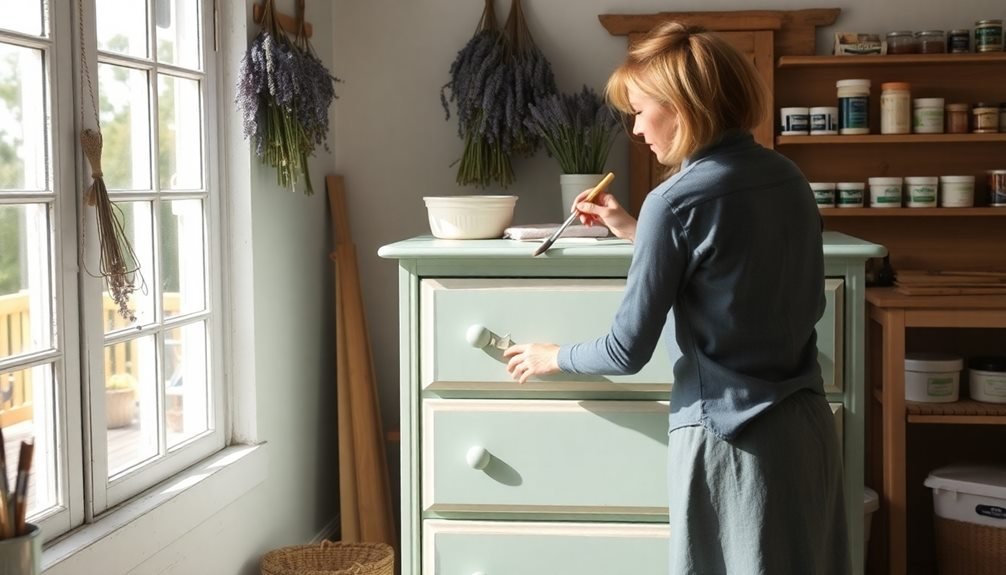
To achieve a serene painting experience, chalk paint application can become a therapeutic ritual when approached mindfully. You'll find that chalk paint's naturally matte finish creates a forgiving surface, allowing you to focus on the peaceful process rather than stressing over perfection.
Create a calm workspace by clearing clutter, playing soft background music, and setting up your materials within easy reach.
Before you begin painting, take three deep breaths and set an intention for your project. Load your brush with paint using deliberate strokes, and maintain awareness of these sensory experiences:
- The gentle swoosh of bristles against the furniture's surface
- The gradual transformation as each stroke builds upon the last
- The earthy scent of mineral-based chalk paint
- The satisfying sight of fresh color flowing from your brush
Apply thin, even coats using long, fluid motions, allowing each layer to dry completely.
Don't rush the process – embrace the methodical nature of painting as a form of moving meditation. Focus on the present moment as you watch the piece transform, letting go of any expectations or judgments about the outcome.
Therapeutic Staining Methods
Apply wood stain mindfully by focusing on each stroke as you follow the natural wood grain patterns, allowing the rhythmic motion to create a meditative state.
You'll find emotional balance by layering different stain colors, letting each shade represent a different feeling or memory as you build depth and character.
Working slowly and deliberately puts you into a peaceful flow state, where your mind can rest while your hands stay busy with the therapeutic process of transformation.
Mindful Wood Grain Meditation
Beneath every furniture piece lies a unique story etched in its wood grain patterns, waiting to be revealed through mindful staining. As you prepare to transform your furniture piece, take a moment to observe the unique swirls, lines, and natural patterns before you. Let this observation become a meditative practice that connects you to the wood's history and character.
Before applying stain, run your hands across the surface, feeling each groove and imperfection. This tactile connection helps you understand the wood's personality and guides your staining technique. You'll notice how different wood grains accept stain uniquely, creating depth and dimension that tell their own stories.
- Watch as each stroke of stain reveals hidden patterns, like uncovering a secret map beneath the surface.
- Feel the calm wash over you as you work in harmony with the wood's natural flow.
- Experience the satisfaction of bringing forgotten beauty back to life.
- Connect with the generations of craftspeople who've worked with this same grain pattern.
Focus on each deliberate movement as you apply the stain, allowing the rhythmic process to quiet your mind and reduce stress. This mindful approach transforms a simple finishing task into a therapeutic journey.
Layer Colors Like Therapy
While many view furniture staining as a single-layer process, layering multiple colors can become a soothing therapeutic practice that mirrors the complexity of your emotions.
Start with a light base color and let yourself connect with the wood's natural patterns as you apply each layer. You'll find that watching the colors blend and interact creates a calming, meditative state.
Begin by selecting three complementary stain colors that resonate with your current mood. Apply your lightest shade first, using long, steady strokes that help regulate your breathing.
Once dry, add your middle tone in gentle circular motions, focusing on how the colors merge and create depth. The final dark layer should be applied sparingly, allowing previous colors to peek through – much like acknowledging different aspects of yourself.
Between layers, practice mindful waiting. Use this time to reflect on how each color transforms the piece.
You can enhance the therapeutic effect by slightly sanding between coats, letting the repetitive motion release tension. The result isn't just a beautifully finished piece – it's a physical representation of your journey through the creative process.
Slow Application Flow State
Finding your flow state during furniture staining requires a deliberate slowdown from the layering process. When you're working with wood stains, you'll discover that mindful application creates both better results and deeper relaxation.
Set your pace by focusing on long, steady strokes that follow the wood grain, allowing yourself to sync with the natural rhythm of the material.
Create your therapeutic staining environment by:
- Feeling the smooth glide of your applicator as it releases the perfect amount of stain, watching the wood grain come alive beneath your hands
- Breathing in harmony with your brushstrokes, letting each exhale guide your movement across the surface
- Observing how each section of wood accepts the stain differently, teaching you patience and acceptance
- Celebrating the meditative quiet as you work, free from the pressure to rush or perfect
Keep your movements consistent and unhurried, letting the stain's absorption time become your natural pause points.
You'll notice your shoulders relaxing and your mind clearing as you develop this mindful approach to furniture finishing, transforming a technical process into a form of stress relief.
Soothing Pattern Design
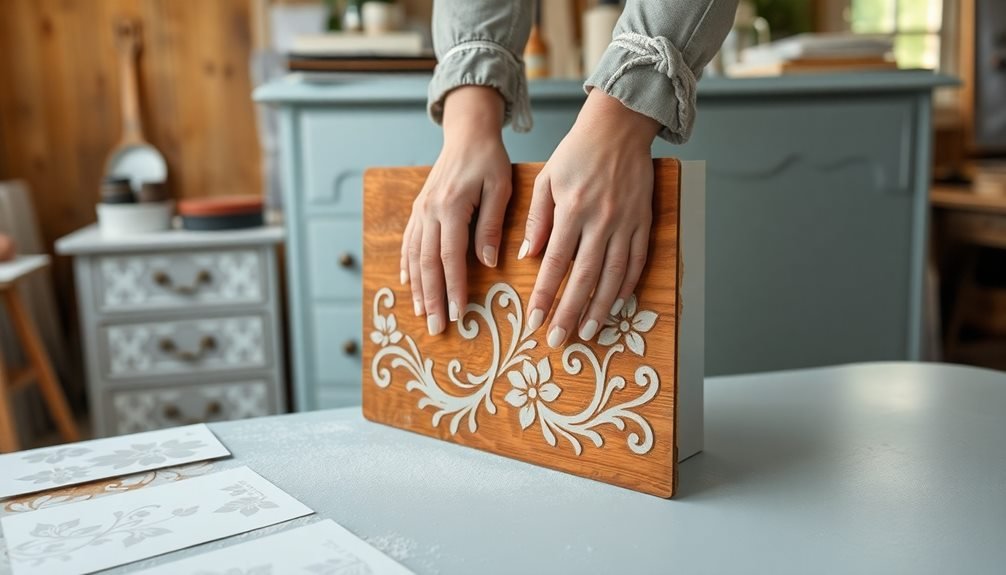
Soothing patterns can transform a flipped piece of furniture from ordinary to extraordinary while promoting relaxation. When you're choosing patterns for your furniture flip, opt for designs that incorporate gentle curves, soft shifts, and natural elements that help reduce stress while working.
Start by sketching flowing lines that mimic ocean waves, clouds, or botanical forms. You'll find that repeating these organic patterns creates a meditative rhythm as you paint or stencil. Consider using mandala designs, which naturally draw your eye inward and help maintain focus during the creative process.
Celtic knots and continuous line patterns also provide a calming effect while adding visual interest.
For maximum stress relief, select a color palette with gentle gradients. Blend cool blues, soft greens, or warm neutrals to create depth without jarring shifts. You can achieve this by layering thin coats of paint or using color-washing techniques.
When applying your chosen pattern, work in sections and maintain steady breathing – this turns the painting process into a mindful exercise. Remember to step back periodically to observe how your pattern flows across the furniture's surface, making adjustments as needed for balance and harmony.
Repetitive Stenciling Practice
Three key benefits make repetitive stenciling an ideal stress-relieving technique in furniture flipping. The rhythmic motion of applying paint through stencils creates a meditative state, while the predictable patterns help quiet your racing thoughts.
You'll find yourself focusing solely on maintaining consistent pressure and spacing, naturally pushing away daily worries and stress.
When you're ready to begin your stenciling practice, choose simple geometric patterns and work in a well-ventilated space. Start with small sections, allowing yourself to develop muscle memory and confidence.
You'll notice your breathing naturally synchronizes with each dabbing motion, creating a calming flow state.
- Feel the gentle resistance as your stencil brush meets the surface
- Watch your chosen pattern emerge, bringing order to blank spaces
- Experience the satisfaction of perfectly aligned repeating elements
- Let your mind drift peacefully as muscle memory takes over
The beauty of repetitive stenciling lies in its forgiving nature. Any small imperfections blend into the overall pattern, teaching you to release perfectionism while creating beautiful, professional-looking results on your furniture pieces.
Peaceful Upholstery Techniques
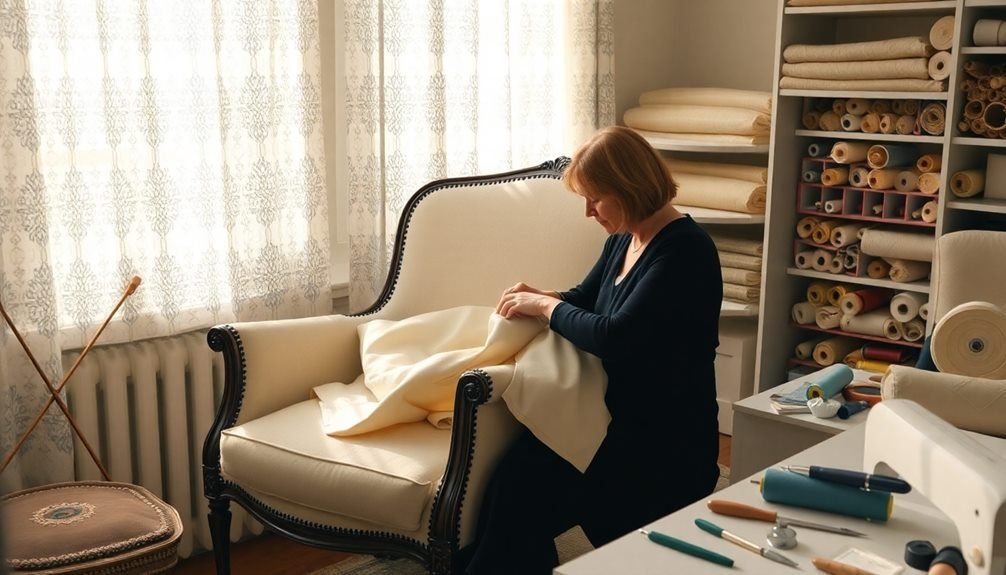
Upholstery's rhythmic movements offer a natural path to mindfulness while transforming furniture. As you remove old fabric and staples, focus on the steady motion of your hands and the satisfying click of the staple remover. Let each repetitive pull become a form of meditation, clearing your mind of daily stresses.
When you're ready to add new fabric, embrace the calming process of measuring and cutting. The gentle glide of fabric scissors through material can become a soothing ritual. Take deep breaths as you align patterns and smooth wrinkles, allowing yourself to be fully present in each step.
Stapling new upholstery creates another opportunity for mindful focus. Position your staple gun with intention, maintaining even pressure and spacing. You'll find peace in the methodical progression around corners and edges. Pay attention to how the fabric responds to your touch, adjusting tension as needed.
For maximum relaxation, choose fabrics that feel pleasant against your skin. Natural materials like cotton and linen offer tactile comfort while you work.
Remember to pause occasionally, step back, and appreciate your progress – this mindful approach transforms both furniture and your state of mind.
Relaxing Wax Finishing
Applying furniture wax brings a meditative quality to your flipping project that rivals the calm of upholstery work.
You'll find your rhythm as you work in small, circular motions, letting your mind focus solely on the smooth, repetitive movements of your hands across the wood's surface. The process demands your full attention while simultaneously allowing your thoughts to settle.
Start by choosing a high-quality furniture wax and a soft, lint-free cloth. Work in one small section at a time, building thin layers rather than rushing to cover the entire piece. You'll notice how the wood grain deepens and glows with each pass.
- Feel the tension leave your shoulders as you buff the wax to a soft sheen
- Watch your worries melt away as the wood's natural beauty emerges
- Experience the satisfaction of creating perfectly smooth, silky surfaces
- Connect with the piece's history through each deliberate stroke
Let the wax cure between layers, using this time to step back and admire your progress.
This mindful approach not only results in a beautiful finish but also provides a therapeutic escape from daily stress.
Frequently Asked Questions
What Tools Should Beginners Invest in Before Starting Furniture Flipping?
You'll need basic tools to start furniture flipping: a sander, screwdrivers, paintbrushes, drop cloths, wood filler, measuring tape, safety gear, and cleaning supplies. Don't forget a drill and quality sandpaper for refinishing work.
How Long Does It Take to Flip One Piece of Furniture?
You'll spend anywhere from 2-10 hours per piece, depending on its condition and your project goals. A basic refinish takes less time, while complex restorations with repairs and custom designs require more work.
Where Can I Find Affordable Vintage Furniture to Restore?
You'll find great deals at thrift stores, estate sales, garage sales, and Facebook Marketplace. Don't forget to check Craigslist, flea markets, and curb alerts in your neighborhood for free furniture finds.
Can Furniture Flipping Become a Profitable Side Business?
You can definitely turn furniture flipping into a profitable side business. With the right sourcing, skills, and marketing strategy, you'll earn good profits. Many successful flippers make $1,000+ monthly through online sales.
Which Pieces of Furniture Are Easiest for First-Time Flippers?
Start with small wooden pieces like end tables, nightstands, or basic chairs. They're manageable, don't require complex repairs, and you'll build confidence quickly. Plus, these items are easy to find and sell.
In Summary
You've now discovered 10 therapeutic ways to transform old furniture while finding inner peace. Whether you're methodically sanding wood, choosing calming colors, or practicing repetitive stenciling, each technique offers a chance to decompress and create something beautiful. Remember, furniture flipping isn't just about restoring pieces – it's about restoring yourself. Take these methods at your own pace and let the creative process soothe your mind.

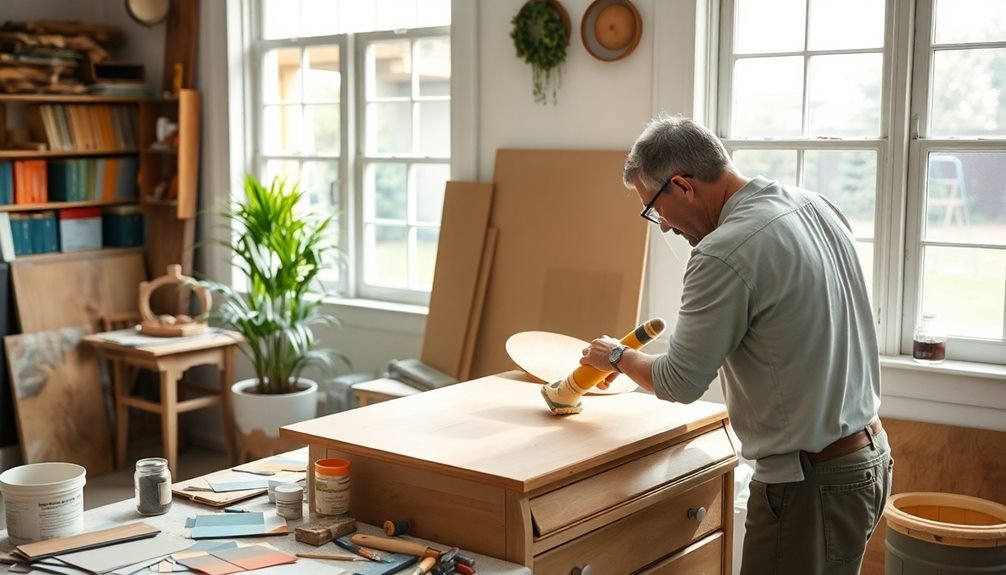
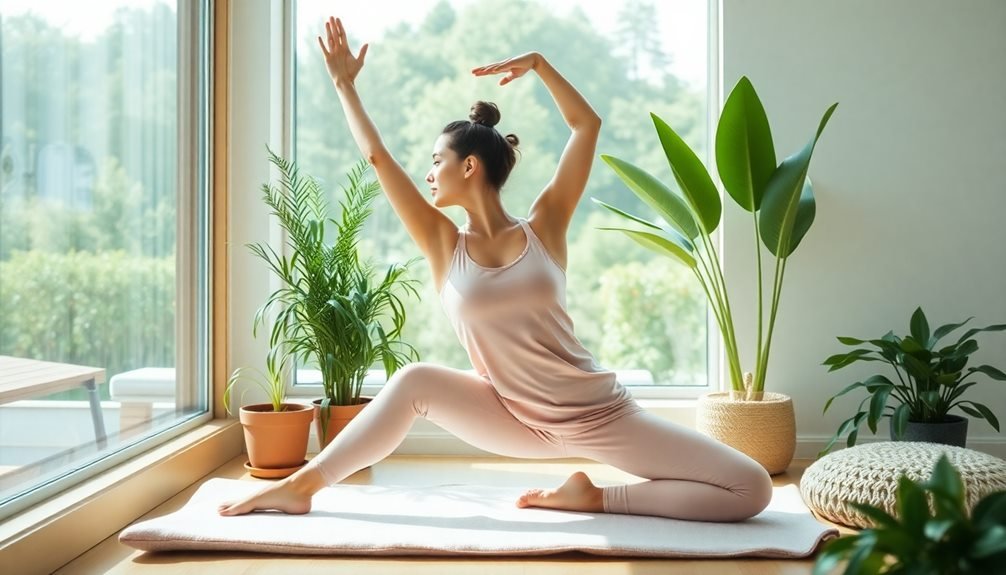
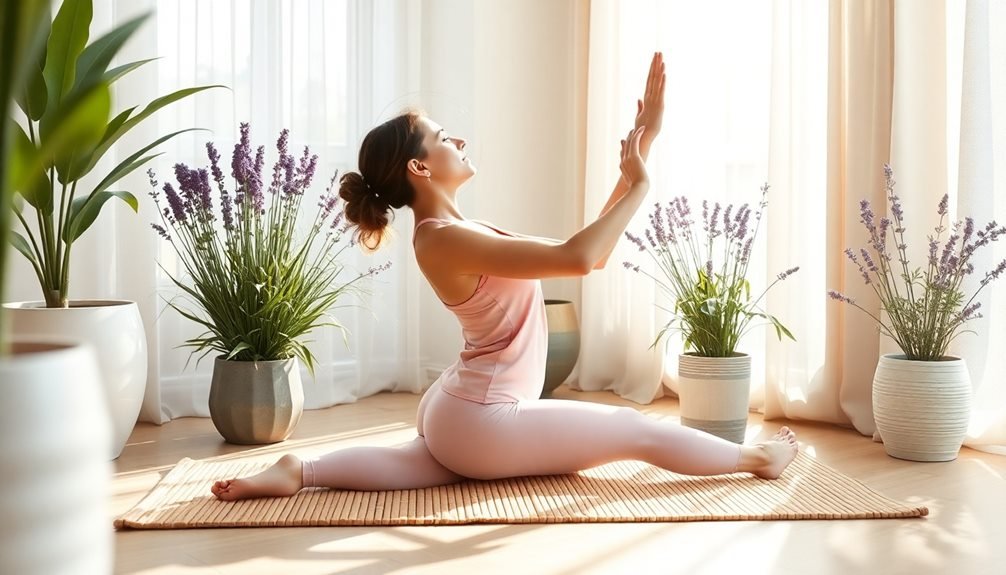

Leave a Reply